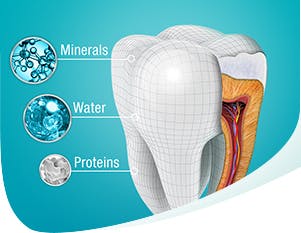Tooth Enamel Erosion: Does Enamel Protect Teeth from Cavities?
Enamel is the hard, outer layer of the tooth that provides a vital layer of protection for the inner layers of your tooth. Keeping your enamel strong is a key step in preventing enamel erosion and tooth decay.
What you eat affects your teeth—especially sugary and acidic foods.i Anytime you eat or drink anything acidic, your tooth enamel becomes softer for a short period of time afterwards.ii In addition, the bacteria that live in your mouth feed on sugar.i Bacteria and sugary food and drink particles build up on your teeth as plaque. Within this sticky substance, bacteria use the sugar in the foods you eat to create acids. Left alone, over time, these acids weaken your tooth enamel and can lead to sensitivity and cause cavities.i,ii
What’s the Difference Between Tooth Enamel Erosion and Cavities?
Though some people may confuse them, erosion of tooth enamel (dental erosion) and cavities are not the same thing. Here are the differences between the two:
- Dental erosion is a chemical process characterized by acid dissolution of dental hard tissue not involving acids of bacterial origin. Erosive demineralization can result in progressive, irreversible loss of tooth mineral substance, and may be caused by intrinsic (e.g., acid reflux and excessive vomiting) and/or extrinsic (e.g., dietary) factors.vii
- Cavities are caused by plaque, or the bacteria in your mouth that eat sugar and secrete acids that attack the tooth mineral. This can cause the enamel to weaken as described above. Once the enamel breaks down, a cavity, or small hole in the tooth, can form.ii,iii
Repeated exposure to plaque bacteria acids or bacterial acid can cause your enamel to lose minerals, which can create a small white spot on your tooth at the site of the loss.iv Once acid attacks have eroded enough enamel to reach the next layer of the tooth, the acids in your plaque bacteria can continue to cause tooth decay deeper in the structure of the tooth.iii
How Enamel Protects Your Teeth from Cavities
Enamel is the hardest substance in the body and the first line of defense against tooth wear, tear, and decay.i Healthy enamel covers the visible part of the tooth, also known as the crown.i
A small white spot on your tooth is not just an early sign of mineral loss—it’s also the first stage of a cavity.i Without proper intervention, this spot of weakened enamel may turn brown or even black and continue to decay.i
Preventing Cavities and Enamel Erosion
Preventing enamel erosion can save you from restorative dental care procedures, such as dental fillings or crowns. Enamel erosion prevention can include:i,iv, vii
- Limiting acidic foods and drinks. Sodas, fruit juices, and some fruit and vegetables are high in acid, which contributes to enamel erosion.
- Limiting sugars. Sugary food can create acid-producing bacteria.
- Brushing and flossing regularly. Brushing twice a day with a fluoride toothpaste and flossing after meals helps remove food and debris from teeth and prevents plaque from forming.
- Using fluoridated oral care products. Fluoride is key to enamel health, as it helps prevent the loss of important minerals in your tooth enamel and reduces the ability of your mouth’s bacteria to produce acids. Fluoride toothpastes and mouthwashes can help ensure you’re providing your teeth with enough care.
- Visiting the dentist. Visiting your dentist regularly for cleanings and examinations can help prevent enamel erosion.
Once enamel is gone, it’s gone—it does not grow back.i Preventing erosion is paramount.
Preventing Cavities by Strengthening Tooth Enamel
It’s possible to fight back against enamel erosion by promoting remineralization. By reintroducing enamel-strengthening minerals to the mouth, areas weakened by acid can be fortified. Ways to remineralize include:ii,iv,v,vi
- Using fluoride products and drinking fluoridated water. Fluoride prevents mineral loss in tooth enamel and replaces lost minerals. It can also reduce bacteria’s ability to make acid. Get fluoride by drinking fluoridated water and brushing twice daily with a fluoride toothpaste.
- Choosing a fluoride toothpaste. Try a specially optimized fluoride toothpaste like Pronamel Active Shield to help strengthen weakened enamel and protect against acid attacks.
- Encouraging saliva production. Dry mouth makes it easy for tooth decay-causing bacteria to weaken enamel.v Saliva contains key restorative minerals that also neutralize acids. Chewing gum can help you produce more saliva—just be sure to choose one without sugar.
- Eating foods rich in essential minerals. Calcium-rich foods are a helpful way to boost remineralization efforts.
- Brush and floss regularly. Maintain your oral hygiene at home by brushing and flossing twice daily.
- Visit the dentist. Visit your dental professional for check ups and teeth cleanings.
Vigilantly caring for your teeth’s enamel goes a long way toward maintaining oral health and preventing problems down the line.ii Preventing enamel erosion and working towards strengthening acid-weakened enamel are effective ways to prevent cavities.iv
Source Citations:
i. Understanding and preventing cavities. MouthHealthy. Oral Health Information from the ADA. https://www.mouthhealthy.org/en/dental-care-concerns/how-do-we-prevent-cavities. Accessed 12/16/22.
ii. Dental erosion. Oral Health Foundation. https://www.dentalhealth.org/dental-erosion. Accessed 12/16/22.
iii. Cavities | MouthHealthy. Oral Health Information from the ADA. https://www.mouthhealthy.org/all-topics-a-z/cavities/. Accessed 12/16/22.
iv. The Tooth Decay Process: How to Reverse It and Avoid a Cavity | National Institute of Dental and Craniofacial Research. https://www.nidcr.nih.gov/health-info/tooth-decay/more-info/tooth-decay-process. Accessed 12/16/22.
v. Tooth Erosion and Acid Reflux | MouthHealthy. Oral Health Information from the ADA. https://www.mouthhealthy.org/all-topics-a-z/tooth-erosion-and-acid-reflux. Accessed 12/16/22.
vi. Foods with Calcium | MouthHealthy. Oral Health Information from the ADA. https://www.mouthhealthy.org/nutrition/8-non-dairy-calcium-rich-foods-for-your-teeth. Accessed 2/2/23.
vii. Dental Erosion. ADA. https://www.ada.org/resources/research/science-and-research-institute/oral-health-topics/dental-erosion. Accessed 2/22/23

.jpg?auto=format)


